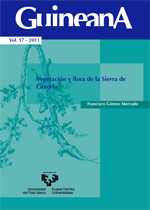Vegetation and Flora of the Sierra de Cazorla
##plugins.themes.bootstrap3.article.main##
##plugins.themes.bootstrap3.article.sidebar##
Abstract
Our study area, the Sierra de Cazorla, is a territory of 47,130 ha located in the southern part of the Natural Park of the Sierras de Cazorla, Segura y las Villas, in the province of Jaén. Basically the area comprises the mountain ranges of Sierra de Cazorla, Sierra del Pozo, Sierra de la Cabrilla, Sierra de las Empanadas and the western flank of the Sierra del Castril. The altitudinal range goes from 590 to 2,106 m.
In order to describe the vegetation dynamics we deal first with the physical profile of the environment, i.e. the geography, geology, pedology, and bioclimatology, together with the anthropic factors. The bioclimate is mediterranean, pluvioseasonal and oceanic. Three thermotypes (meso-, supraand oromediterranean) and three ombrotypes (dry, subhumid and humid) have been identified. Most of the territory belongs to the Cazorlensean Subsector (in the Subbetic Sector of the Betic Province), but it also includes small borderline zones of the Hispalensean Sector and Guadician-Bacensean Sector.
The vegetation is studied from a phytosociological point of view. The syntaxonomical catalogue comprises 86 plant associations or communities belonging to 30 phytosociological classes, of which three new associations and one new subassociation are described for the first time. We also describe and depict 10 vegetation series and subseries (faciations) cartographically. The riparian geoseries, not represented on the maps, are also described. To plot the current vegetation map, which presents 253 polygons grouped into 46 types of legend, the area covered by each of these series is arranged into units, i.e. physiognomical degradation states. We provide the location, defining environmental factors, physiognomy, floristic composition, symphytosociology and ecological dynamics and significance of each of these units.
Finally, we focus on the floristic catalogue, which has 1,815 items, 115 of them corresponding to families. We comment on 1,700 species or subspecies, of which another 110 are exclusions. Consequently, the number of taxa in the species catalogue reaches 1,590. For each taxon we provide not only the correct name and main synonyms, but also an estimate of its relative abundance in the area, environmental behaviour and phytosociological position (with the reference of the herbarium sheets).

